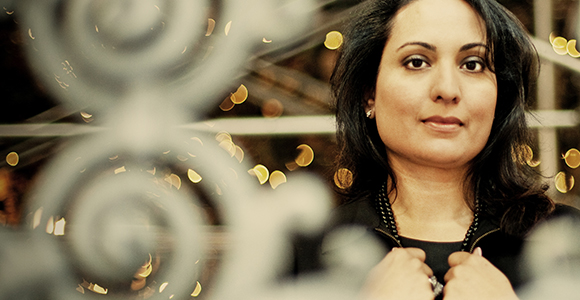
STYLE
Suit yourself
Nothing to wear to the office? Gurjot Sidhu, AB’90, MBA’93, has some ideas.
Mitchell Kohles, AB’12
Standing in the reception area of her Madison Avenue office, Gurjot Sidhu, AB’90, MBA’93, holds up a small women’s jacket: a simple, trim, one-button piece made of thick black wool. “This is what Hillary wore when she accepted the nomination for secretary of state.” Gurjot passes the jacket around the room so the members of Themis Legal Network, a New York–based network of women lawyers, can feel the material.
Next she picks up a length of loose fabric straight off the bolt. The uncut wool, called Super 140 to indicate how fine the fibers are, shimmers like silk. “This is what Obama wore when he shook her hand.” She drapes the fabric over her shoulder, turns to the side, and bends her knee a bit. “How powerful do I look?”
Sidhu has invited the lawyers’ group to her sixth-floor showroom to learn about her line of luxury women’s businesswear. After mingling over wine and cheese, the 30 or so women listen to Sidhu talk about personal branding and workplace dress code. Then comes a short fashion show, followed by more socializing and, of course, shopping.
In 2010 Sidhu launched her eponymous label, Gurjot New York, because she wanted to “glamorize the working woman” and simplify the messages women receive about office dress. In the past few decades women have begun to dress for high-level positions once available only to men. The result, says Sidhu, is a confused game of catch-up, with women trying to balance the demands of individuality, professionalism, and status, and designers doing their best to provide.
In addition to inferior fabrics—you won’t find Super 140 wool at high-end women’s retailers, but you will at men’s—women have to contend with a wider range of businesswear staples, none as established as the suit. “We call it the ‘funky zipper syndrome,’” Sidhu says, referencing a jacket she once saw in a department store: “This perfectly great jacket, and there’s this weird diagonal zipper” across the chest. From a design perspective, the zipper is “totally legitimate,” but in the office, “the funky zipper is not going to cut it.”
Sidhu started sewing at seven. At the College she kept a sewing machine in her room and “wore every trend and every style and every version.” But an undergraduate degree in economics soon set her on the path to the office. “As the child of Indian immigrants, getting a job in fashion was out of the question,” she says.
After graduation she worked at the Federal Reserve in Chicago while taking evening classes at the business school. Newly married and having earned her MBA, Sidhu moved to Washington, DC, in 1993 to help government agencies adopt more efficient business practices from the private sector.
“My parents wanted me to be a doctor or a lawyer. Consultant was good enough.”
In 1996 Sidhu moved to New York and eventually started her own e-commerce consulting firm, i2e Strategy. In 2002 she took some time off: “I was very satisfied with my career progress, so I decided to stop and watch the kids for a while.” She took on occasional consulting projects and mulled what to do next. “All the ideas I had came back to supporting and advancing women in the workplace. I finally was very inspired by the idea of combining my interest in fashion with the desire to see women succeed.” In 2009 she enrolled at the Fashion Institute of Technology, met with designers and patternmakers, and began creating samples.
Sidhu’s original Custom Collection, which she launched along with her label in July 2010, spares no expense in making amends for past shortcomings—customers can get jackets, pants, and dresses made with Super 140 Italian and English wool, all of it lined in silk. Practical features include an inside cell phone pocket in the jacket and a wrap dress with a fabric-covered privacy snap on the neckline (to prevent wardrobe malfunctions).
In January Gurjot launched an off-the-rack line, the Ready Collection; prices range from $55 for a silk ruffle (which can be added to the blouses or sheath dresses) to $525 for the one-button jacket shown below. After some experimentation, Gurjot designed a jacket with several layers of canvas between the wool exterior and silk lining. Canvas, which lends structure, is ubiquitous in men’s jackets but not women’s, because many designers presume women prefer softer, more flowing clothing.
In early 2012, after moving into her Madison Avenue office, Sidhu wanted to hire a Metcalf Intern to write web content, consult on new designs, and help manage operations. Alex Laas, AB’12, started that June. Four weeks into the internship, Laas became Gurjot’s first full-time employee.
Like Sidhu, Laas has a long history of making clothes. As a child she helped her older sister design clothing and costumes for school theater productions. At the College, as a designer for the fashion club MODA, Laas spent hours sewing pieces worn by student-models sweeping down the runway
at Chicago’s Union Station. Laas, who majored in visual arts, also did a fashion show for her senior project.
During her interview, Laas’s stories of designing for MODA, which was founded in 2003, caught Sidhu’s attention; it’s an opportunity Sidhu wishes she’d had in the College. When it came time for the first Gurjot fashion show last July, Laas was the one with experience—fitting the models, ordering the pieces, “and making sure that everyone’s got their walk down,” Gurjot says. “She knew the ropes more than I did.” Laas, for her part, is sure it wasn’t her own attire that made her invaluable to Sidhu. “I was one of those girls, perplexed and disoriented about workwear,” she says. “I came to work wearing my mom’s clothes.”
Leadership style
The Madison Jacket: At $525, this jacket is the priciest item in Gurjot’s new Ready Collection. The line includes slacks, skirts, tops, dresses, and a wide range of accessories from cocktail rings to purses. Gurjot’s suggestion: “Wear a suit jacket, or roll up the sleeves and wear with jeans as a boyfriend jacket.”

